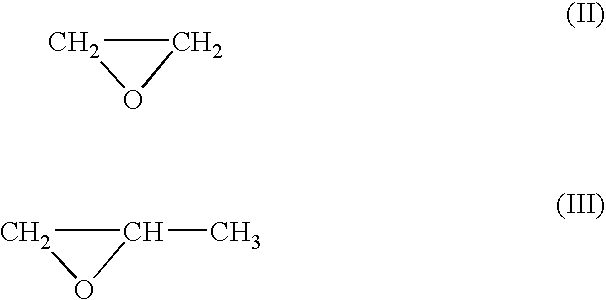Process for production of alkyllene oxide polymers
a technology of alkyllene oxide and polymer, which is applied in the field of alkyllene oxide polymer production, can solve the problems of unclear knowledge and low yield of polymers, and achieve the effect of efficient production of alkyllene oxide polymers
- Summary
- Abstract
- Description
- Claims
- Application Information
AI Technical Summary
Benefits of technology
Problems solved by technology
Method used
Image
Examples
example 1
[0022]Catalyst Preparation
[0023]First, nitrogen displacement operation was performed to a 200 cm3 four-necked flask equipped with a stirrer, a cooling tube and a dropping funnel.
[0024]Next, a mixed solution was prepared by adding in this flask 18.3 grams of 2-methyl pentane (manufactured by Wako Pure Chemical Industries Ltd.) as a solvent, 47.7 grams of a high boiling-point aliphatic hydrocarbon (brand name: No. 0 solvent, manufactured by Nippon Oil Corporation), and 7.4 grams (0.06 mol) of diethyl zinc (manufactured by Nihon Tokushu Kagaku Kogyo Ltd.)
[0025]Next, 4.3 grams of 1,4-butanediol was dripped slowly, spending an hour, to the mixed solution while the solution was vigorously stirred at 10° C. After the dripping was finished, the mixture was stirred at 30° C. for an hour to allow reaction, and then stirring was continued at 50° C. for an hour to allow reaction.
[0026]Next, while the solution was kept at a temperature of 20° C., 3.6 grams of ethyl alcohol (manufactured by Japan...
example 2
[0031]Nitrogen displacement was performed to a 1000 cm3 pressure container. To this container were added 345 grams of 3-methyl pentane (manufactured by Wako Pure Chemical Industries Ltd.) as a solvent, and 0.47 grams of the catalyst (containing 0.5 mmol zinc) obtained in Example 1. The mixture was stirred to dissipate the catalyst uniformly in the solvent.
[0032]Next, 84 grams (1.91 mol) of ethylene oxide (manufactured by NIPPON SHOKUBAI Co., Ltd.) was added. Then, the container was tightly plugged and bathed in a thermostat at 40° C. for two hours under stirring, to allow polymerization reaction.
[0033]After the polymerization reaction was over, a white product was filtrated from the solvent and was dried at 40° C. for five hours under vacuum, to obtain 77 grams of polyethylene oxide. According to the present embodiment, yield of polyethylene oxide with respect to ethylene oxide was 91.7%.
example 3
[0034]Nitrogen displacement was performed to a 1000 cm3 pressure container. To this container were added 345 grams of 2-methyl pentane (manufactured by Wako Pure Chemical Industries Ltd.) as a solvent and 0.94 grams of the catalyst (containing 1.0 mmol zinc) obtained in Example 1. The mixture was stirred to dissipate the catalyst uniformly in the solvent.
[0035]Next, were added 75 grams (1.70 mol) of ethylene oxide (manufactured by NIPPON SHOKUBAI Co., Ltd.) and 11 grams (0.19 mol) of propylene oxide (manufactured by Nihon Oxirane Co., Ltd.). Then, the container was tightly plugged and bathed in a thermostat at 40° C. for two hours under stirring, to allow polymerization reaction.
[0036]After the polymerization reaction was over, a white product was filtrated from the solvent and was dried at 40° C. for five hours under vacuum, to obtain 77 grams of ethylene oxide / propylene oxide copolymers. According to the present embodiment, yield of ethylene oxide / propylene oxide copolymers with r...
PUM
| Property | Measurement | Unit |
|---|---|---|
| Temperature | aaaaa | aaaaa |
| Ratio | aaaaa | aaaaa |
Abstract
Description
Claims
Application Information
 Login to View More
Login to View More - R&D
- Intellectual Property
- Life Sciences
- Materials
- Tech Scout
- Unparalleled Data Quality
- Higher Quality Content
- 60% Fewer Hallucinations
Browse by: Latest US Patents, China's latest patents, Technical Efficacy Thesaurus, Application Domain, Technology Topic, Popular Technical Reports.
© 2025 PatSnap. All rights reserved.Legal|Privacy policy|Modern Slavery Act Transparency Statement|Sitemap|About US| Contact US: help@patsnap.com



